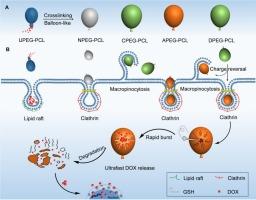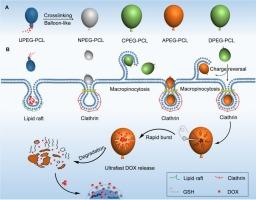具有可调节的带电和可破裂界面的气球状聚合体,用于控制药物输送
IF 11.5
1区 医学
Q1 CHEMISTRY, MULTIDISCIPLINARY
引用次数: 0
摘要
高分子药物载体固有的不稳定性、低反应效率和缺乏功能性阻碍了其临床应用。通过简单的分子设计来解决这些挑战仍然是一个重大障碍。在这里,我们介绍了一种使用结构简单,可点击的两亲二嵌段共聚物聚合物的新方法。我们的策略涉及不对称功能化界面交联,它改变界面曲率,诱导聚合物膨胀,并通过二硫化物键交联网络稳定这种亚稳态,让人想起一个膨胀的气球。此外,交联剂的侧链官能团提供了具有可控和可切换表面电荷的自组装结构。这一特性允许在体内操纵纳米颗粒内化途径、组织分布和肿瘤靶向效果。值得注意的是,这些功能化的球状聚合体在谷胱甘肽的刺激下可以迅速破裂,从而促进细胞内药物的有效和特异性释放。本研究有效解决了二嵌段共聚物载体长期存在的稳定性、释放性和功能性难题,为开发具有重大临床转化潜力的智能药物载体铺平了道路。本文章由计算机程序翻译,如有差异,请以英文原文为准。


Balloon-like polymersomes with tunable charged and burstable interfaces for controlled drug delivery
Inherent instability, low response efficiency, and lack of functionality have hindered the clinical application of polymer drug carriers. Addressing these challenges through straightforward molecular design remains a significant obstacle. Here, we introduce a novel approach using a structurally simple, clickable amphiphilic diblock copolymer vesicle. Our strategy involves asymmetric functionalized interfacial crosslinking, which modifies the interfacial curvature to induce polymersome swelling and stabilizes this metastable state through a disulfide-bond-crosslinked network, reminiscent of an inflated balloon. Moreover, the side chain functional groups of the crosslinking agent provide the self-assembled structures with controllable and switchable surface charges. This feature allows for the manipulation of nanoparticle internalization pathways, tissue distribution and tumor targeting efficacy in vivo. Notably, these functionalized balloon-like polymersomes can burst rapidly under the stimulation of glutathione, thereby facilitating efficient and specific intracellular drug release. This study presents an effective solution to the longstanding dilemma of stability, release, and functionality in diblock copolymer carriers, paving the way for the development of intelligent drug carriers with significant clinical translation potential.
求助全文
通过发布文献求助,成功后即可免费获取论文全文。
去求助
来源期刊

Journal of Controlled Release
医学-化学综合
CiteScore
18.50
自引率
5.60%
发文量
700
审稿时长
39 days
期刊介绍:
The Journal of Controlled Release (JCR) proudly serves as the Official Journal of the Controlled Release Society and the Japan Society of Drug Delivery System.
Dedicated to the broad field of delivery science and technology, JCR publishes high-quality research articles covering drug delivery systems and all facets of formulations. This includes the physicochemical and biological properties of drugs, design and characterization of dosage forms, release mechanisms, in vivo testing, and formulation research and development across pharmaceutical, diagnostic, agricultural, environmental, cosmetic, and food industries.
Priority is given to manuscripts that contribute to the fundamental understanding of principles or demonstrate the advantages of novel technologies in terms of safety and efficacy over current clinical standards. JCR strives to be a leading platform for advancements in delivery science and technology.
 求助内容:
求助内容: 应助结果提醒方式:
应助结果提醒方式:


